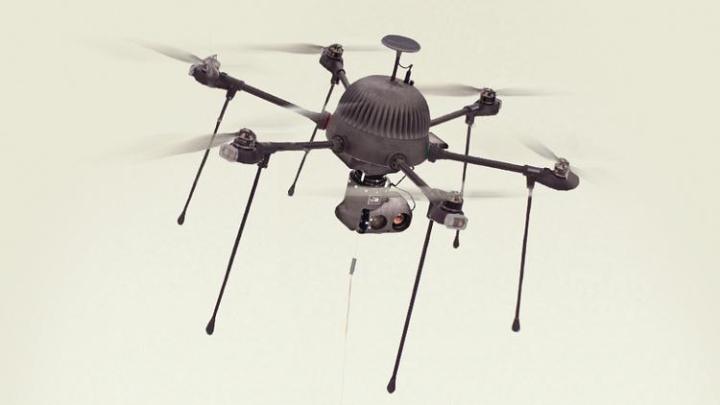
The Parc drone was a product of CyPhy Works’s mission to solve the problem of battery charge and data downloads that limit flight duration. Because Parc runs data transmission and a constant power source through a microfilament tether, it solves some of drone flight’s most pressing problems, but also introduces news ones. Tethered flight means the drone’s range of distance is limited, but the constant exchange of data and power through the microfilament extension means that the Parc drone can stay in the air for virtually unlimited flight time.
Parc’s name is actually an acronym for the PARC system: Persistent Aerial Reconnaissance and Communications. Parc drones can operate at up to 500 feet above ground level, transmitting all data and power through an Ethernet connection embedded in the microfilament between the Parc drone and the accompanying Ground Control Station. The microfilament itself is thinner than your standard headphone cable, but strong enough to reel the drone back down for landing if necessary.
Aside from the freedom lost in the tethered technology, there are plenty of benefits to the Parc drone. Its streamlined design and long-lasting, no-maintenance effectiveness minimizes the logistical footprint and prior training required to operate it. The direct Ethernet connection in the filament creates an added level of security around the data being transferred, which could theoretically include highly sensitive information. Parc is also equipped with a high-definition, gyro-stabilized video camera and infrared capabilities for night-vision recording.
“It’s basically a robot with unlimited time-of-flight. You send it up and it stays there,” said Cyphy Works founder Helen Greiner at the EmTech 2015 conference in Cambridge, Massachusetts last week. CyPhy envisions the Parc drone playing a role in reconnaissance and surveillance programs, or as a communications relay in any number of industries or uses. Parc’s fundamentally tethered technology may keep it from candidacy as a delivery drone, but that doesn’t mean CyPhy isn’t exploring other drone tech options.
As companies like Google and Amazon move quite publicly towards the future of drone delivery, it’s no surprise that CyPhy Works’s most recent funding round of $22 million was collected from UPS, in addition to a slew of more standard venture capital firms. CyPhy’s hobbyist drones currently under development are untethered models, and they have already announced they are working on proprietary drone delivery technology.


